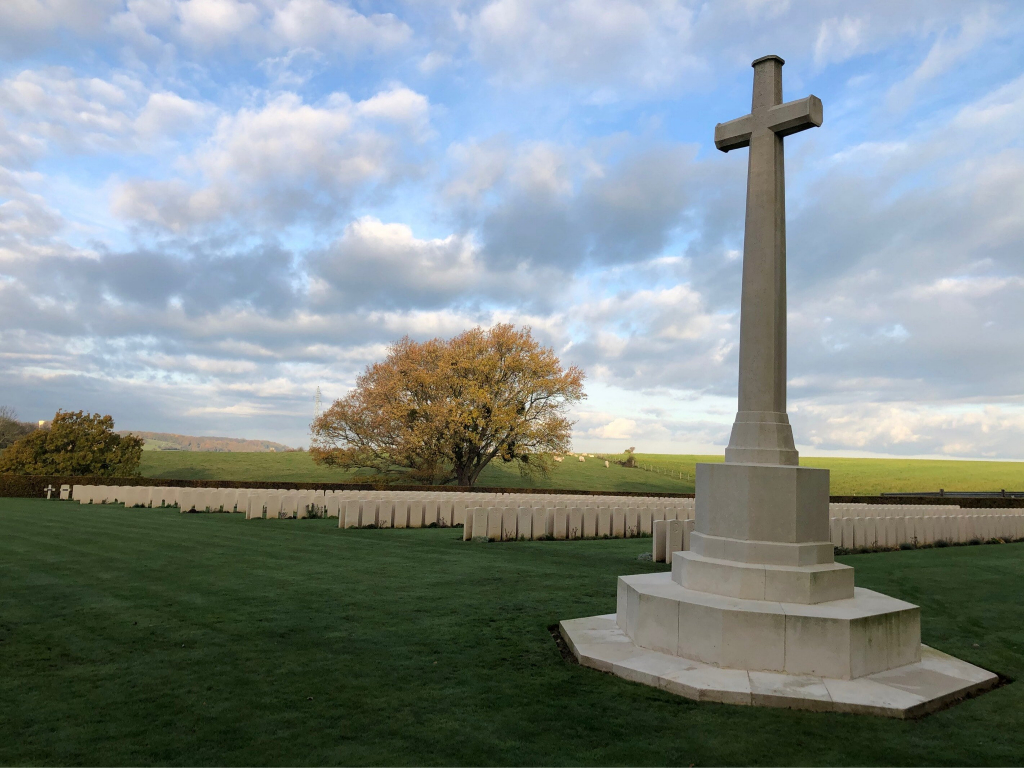Dieppe Canadian War Cemetery, Hautot-Sur-Mer
- Country France
- Total identified casualties 765 Find these casualties
- Region Seine-Maritime
- Identified casualties from Second World War
- GPS Coordinates Latitude: 49.89626, Longitude: 1.0681
Location information
From the centre of Dieppe take the Avenue Gambetta and Avenue des Canadiens. Head along the N27 out of Dieppe in the direction of Rouen until the first roundabout where there is a CWGC sign. Go across the roundabout and continue until you reach a second roundabout. Take the first turning right where there is another CWGC sign. Continue until Chemin des Jonquilles, a road on the left. The cemetery is on the right of this road and is clearly visible.
Visiting information
ARRIVAL
The cemetery is signposted.
PARKING
It is possible to park at the side of the main road (Ch. des Jonquilles) next to a path within 2 metres of the main entrance to the cemetery.
There is a dedicated parking accessible bay marked in the parking area.
The main road is flat and wide with a pavement between the cemetery wall and road. There is a 5-centimetre lip kerbstone between the pavement and the main road.
The ground is flat and firm.
ACCESS LAYOUT AND MAIN ENTRANCE
There are 2 entrances to the front of the cemetery at either end of the entrance structure central wall, facing the road. Tarmac slopes downwards from the footpath to the openings in the wall over 1.2 metres wide, with a metal drainage grille at the junction of tarmac and internal paving.
Both entrances open onto a paved area, with a raised grass areas surrounding the Stone of Remembrance behind the entrance structure.
There is seating along the length of the inside wall of the entrance behind the Stone of Remembrance.
Steps lead down into the burial area from the raised platform on either of the Stone of Remembrance. To the left of the entrance structure, there is step-free access to the burial area at the edge of the paving that marks the edge of the entrance structure, towards the Cross of Sacrifice.
The Cross of Sacrifice is to the left of the entrance in line with the Shelter building on the right side of the cemetery.
Inside the shelter is a stone bench seating area and the cemetery Register Box built into the rear wall above the seat. There are 2 stone steps up to the shelter from the grass.
Behind and in line with the Cross of Sacrifice against the left side of the cemetery, viewed from the entrance, and at the rear left side of the cemetery are stone bench seating areas.
The cemetery internal paths are grass, the cemetery is on a gentle slope.
ALTERNATIVE ACCESS
ADDITIONAL INFORMATION
The cemetery is permanently open.
History information
The Dieppe Raid of 18-19 August 1942 was the first large scale daylight assault on a strongly held objective on the Continent since the Allied withdrawal of 1940. The objectives of the raid were the destruction the Dieppe defences and neighbouring radar and aerodrome installations, the raiding of a German divisional headquarters close by and the capture of prisoners. The largely Canadian military force undertook the main assault on Dieppe itself, with flanking assaults by Commando units and additional Canadian battalions to the east and west of the town intended to neutralise batteries that commanded the direct approach. Support was provided by more than 250 naval vessels and 69 air squadrons.
Only the assaulting parties on the extreme flanks came within reasonable reach of their ambitious objectives and casualties were very heavy, with more than 3,600 of the military force of 6,100 killed, wounded, missing or captured. Naval casualties numbered 550.
Many of those who died in the raid are buried at Dieppe Canadian War Cemetery, where 948 Commonwealth servicemen of the Second World War are now buried or commemorated, 187 of which are unidentified. There are 7 non Commonwealth and 2 non World War burials here. Other casualties of the raid are at Rouen, where some of the wounded were taken to hospital.
Dieppe Canadian War Cemetery, designed by Philip Hepworth, was the first new cemetery of the 1939-45 war to be completed in 1949.



